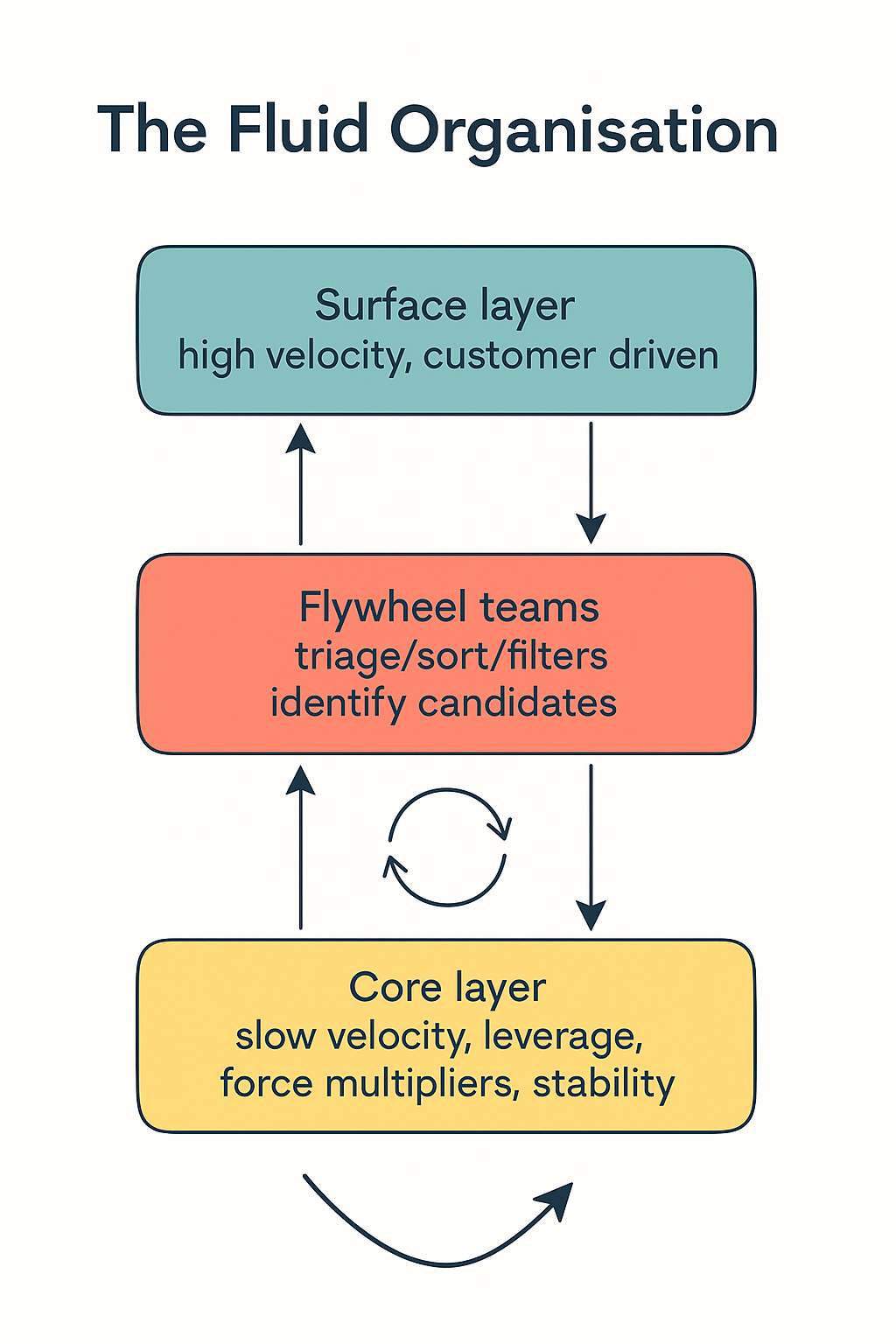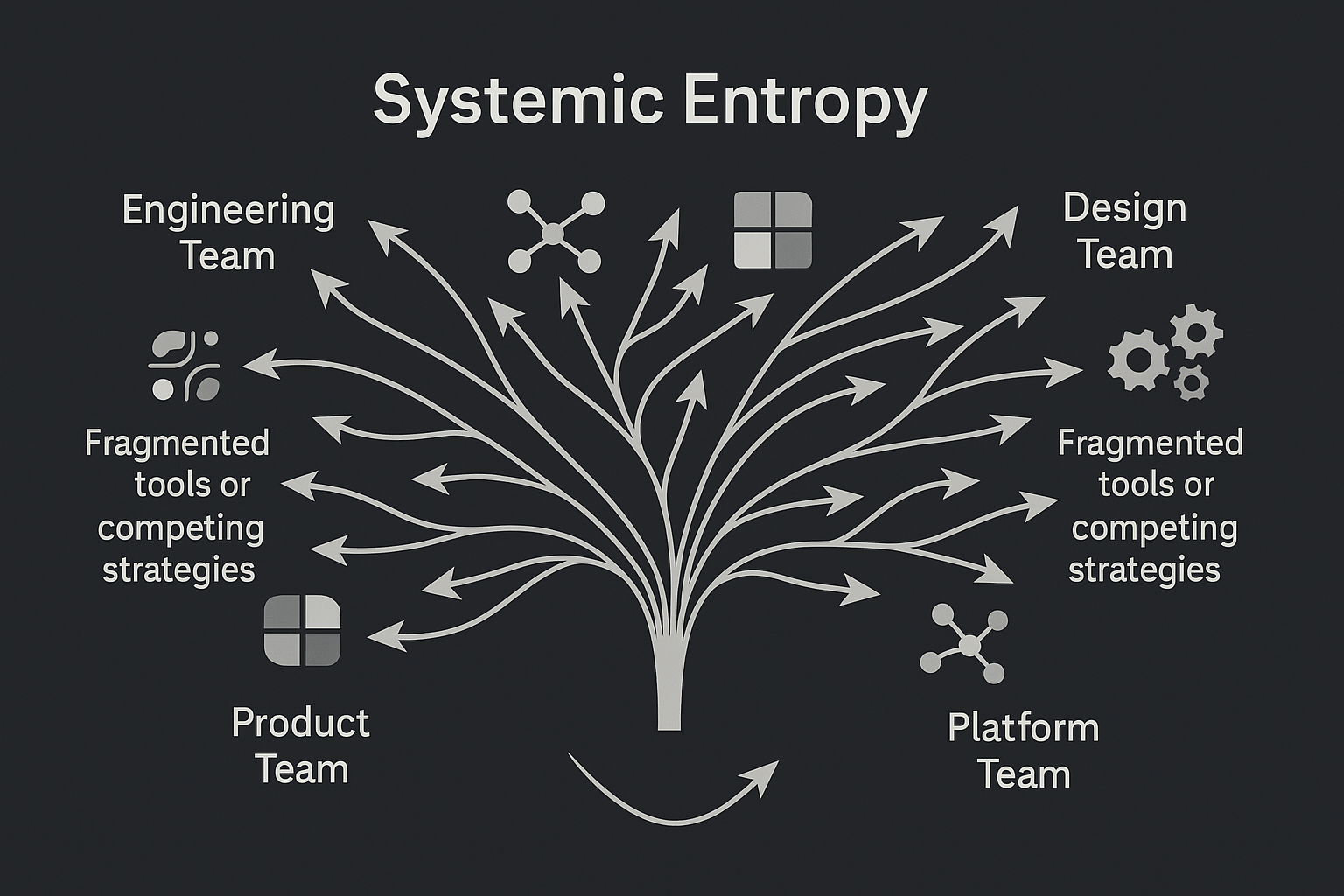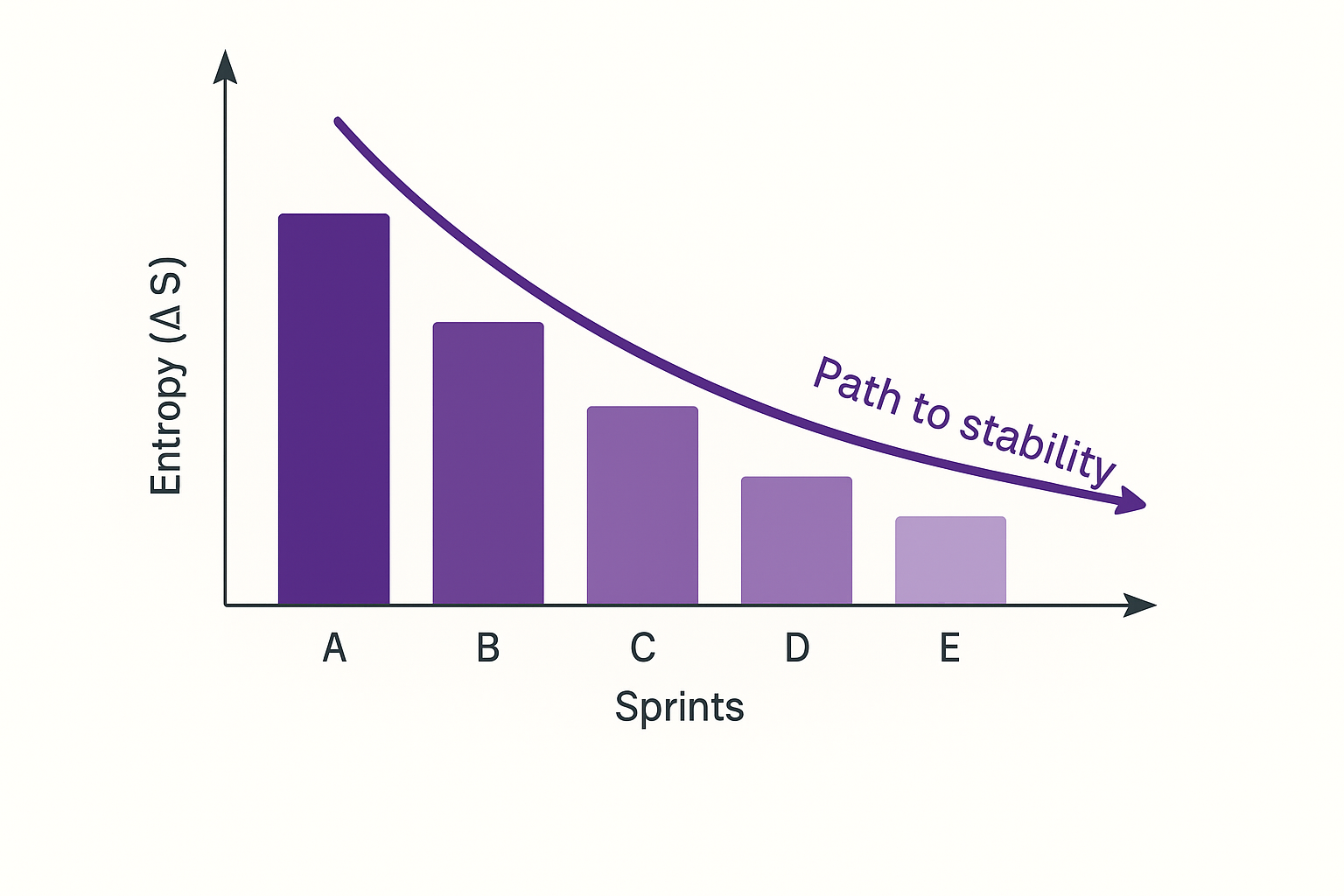From Chaos to Coherence: How the Fluid Org Flywheel Reduces Organisational Entropy

Modern organisations do not suffer from a lack of ideas or energy. What they suffer from is signal decay, duplicated effort, and structural noise. As organisations scale, the cost of change does not come from lack of speed, but from increasing disorder. The problem is not slowness but entropy.
In this article, we explain how the Flywheel concept introduced in the Fluid Organisation can be understood as a response to organisational entropy. We offer a simple proxy formula for entropic pressure, expand on the convergence toward stability, and explore a real-world example of how coherence can emerge from chaos.
What is the Fluid Organisation?
Before diving into entropy, let us briefly summarise the model. The Fluid Organisation proposes that different layers of a system move at different speeds by design:
- Surface: High-velocity, exploration-driven, market-facing teams
- Flywheel: The dynamic interface layer that absorbs, triages, and filters signal
- Core: Stable, reusable, foundational infrastructure
The Flywheel does not enforce control, it metabolises signal into coherence. It is where structure emerges, not where it is dictated. Its function is to protect both exploration and reuse by allowing velocity to vary across layers without causing system collapse.

What Entropy Looks Like in an Organisation
Entropy is the drift from clarity to chaos. In practical terms, it looks like:
- Multiple teams building overlapping solutions to the same problem
- Rapid delivery with unclear boundaries or ownership
- Fragmented tooling or repeated decisions with no shared learning
- Output velocity that exceeds the system's ability to absorb and reuse
As these forces accumulate, reuse becomes harder, platform integrity suffers, and motion loses meaning.

The Flywheel as an Entropy Buffer
The Flywheel does not prevent entropy. It absorbs and metabolises it. When structured well, it slows the rate at which chaos leaks downward. It allows product teams to move fast, while gradually channelling the most stable patterns into reusable infrastructure.
This is what makes the Flywheel a transducer. Not a project team, not a glue layer. It converts exploration into structured motion.
A Simple Formula for Entropic Pressure
To assess systemic friction, we introduce a lightweight proxy we call Entropic Pressure. Unlike entropy, which describes overall disorder, pressure implies dynamic tension, we introduce it as a measure of how strongly motion is acting against system structure. In physical systems, pressure can be felt even in structured environments. Likewise, in organisations, Entropic Pressure reflects the organisational strain caused by high throughput moving through unclear or unstable boundaries.
Entropic Pressure = (Interface Change Rate × Delivery Velocity) ÷ Interface Maturity
Where:
- Interface Change Rate: how frequently teams alter their APIs, workflows, or expectations
- Delivery Velocity: how much is being shipped
- Interface Maturity: a rough score (1–5) that reflects documentation, ownership, versioning, and discoverability
Because Interface Maturity is a semi-qualitative input, it may require team calibration to be applied consistently. Just as estimation rituals like sprint poker need a shared understanding of complexity, teams should align on what constitutes maturity to avoid distortion.
This formula allows us to assess not how fast we are moving, but whether that speed is sustainable. When Entropic Pressure is high, motion risks becoming noise.
Delta Entropy and the Path to Stability
Entropy in a system is never zero. But a healthy Flywheel ensures that the rate of change of entropy (Delta Entropy or ΔEntropy or ΔS ), declines over time.
- In early-stage teams, entropy is high and unpredictable. That is natural.
- Over time, as reuse increases and triage mechanisms mature, ΔEntropy (change per unit time) flattens.
- When the system no longer requires constant firefighting to remain coherent, the Flywheel is working.
This is convergence. Not perfection, but managed evolution.

A Real Example: CI/CD Fork Explosion
A product team creates a rapid rollback script for CI/CD. Three other teams copy it. Each team modifies the script differently.
Six weeks later, five versions exist, none are documented, standardised, or reusable. The code base has become unstable, and platform teams are unaware of the proliferation.
Week 0: Initial Forking Begins
(Start of Sprint 1 : initial divergence begins)
- 1 team creates a rollback script
- 3 other teams adopt and modify it independently (no coordination or feedback loops)
- No shared repository, no ownership, no documentation, knowledge is trapped locally
Metrics:
- Interface Change Rate (D) = 5
- Delivery Velocity (V) = 8
- Interface Maturity (M) = 1.5
- Entropic Pressure = (5 × 8) ÷ 1.5 = 26.7
- ΔEntropy is rising rapidly
Week 3: Flywheel Triage Begins
(Post Sprint 2 : Flywheel begins triage and pattern design)
- Enablement team interviews 2 teams, reviews forks and divergence points
- Identifies duplication and risk in differing rollback logic
- Starts co-designing a paved rollback pattern based on the two most stable implementations (teams still tweaking their own forks)
Metrics:
- D = 3
- V = 8
- M = 2.5
- Entropic Pressure = (3 × 8) ÷ 2.5 = 9.6
- ΔEntropy begins to slow
Week 5: Unification Phase
(End of Sprint 3 : unification and reuse begins to scale)
- Golden rollback pipeline template is published with documented parameters and guardrails
- 4 of 5 teams adopt the unified version (fifth team maintains local variant for legacy constraints)
- Platform adds it to the paved path catalogue and enables telemetry on usage
Metrics:
- D = 1
- V = 7
- M = 4.5
- Entropic Pressure = (1 × 7) ÷ 4.5 = 1.56
- ΔEntropy is trending toward zero : convergence achieved !
Why This Matters
When reuse happens too early, innovation is stifled. When it happens too late, entropy consumes the system. The Flywheel offers a third path: decentralised exploration with a structured path to convergence.
It enables an organisation to handle high delivery velocity without allowing fragmentation to dominate. It enables systems to evolve while remaining coherent.
When ΔEntropy begins to trend toward zero, the system has entered the path to stability.
Try This in Your Team
- Track interface maturity qualitatively across one or two sprints
- Estimate Entropic Pressure weekly using observed volatility and reuse
- Use the trend to identify where the Flywheel is under-dimensioned or where reuse is breaking down
In engineered systems, pressure without structure leads to rupture. In organisations, it leads to incoherence.
Conclusion: Coherence Is Earned
The Flywheel does not enforce stability. It enables it.
As entropy declines, system motion becomes clearer. Innovation is still possible, but it no longer fragments the whole. Teams continue to move fast, but their output feeds back into the system in a structured, metabolised way.
This is not just an architecture. It is a way of managing energy, noise, and evolution.
If your organisation struggles with reuse, chaos, or friction, it may not need more speed. It may need a Flywheel.
Marc Daniel Ortega





Member discussion